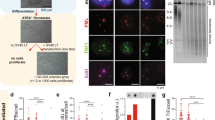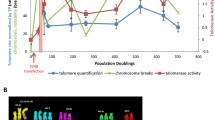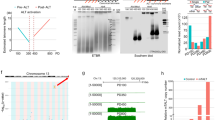Abstract
Subtelomeric reporter genes in human cells are silenced in a telomere length-dependent manner. Here we show that a subtelomeric reporter gene is expressed in only a subpopulation of cells within a clone and that this heterogeneity is generated by switching between expression states. We observed frequent reversion from the silenced state back to active expression. This process was more prominent for subtelomeric transgenes; however, we also observed cases of spontaneous reversion in control clones bearing the reporter at an internal site. We additionally show that treatment of these cells with 5-bromodeoxyuridine results in strong activation of the transgene. Although similar findings have been reported previously in mouse cells, this is, to our knowledge, the first direct observation of ongoing fluctuations in transcription in clonal populations of human cells. Our results suggest that this mechanism, as opposed to progressive silencing or a delayed fixing of expression states, accounts for the variegation in expression observed for subtelomeric transgenes in human cells. These data imply that telomere shortening during human aging could lead to stochastic activation of subtelomeric genes.





Similar content being viewed by others
Abbreviations
- BrdU:
-
5-Bromodeoxyuridine
- CMV:
-
Cytomegalovirus
- DsRed2:
-
Discosoma sp. red fluorescent protein
- FACS:
-
Fluorescence activated cell sorting
- hTERT:
-
Human telomerase reverse transcriptase
- hTPE:
-
Human telomere position effect
- IRES:
-
Internal ribosome entry site
- TPE:
-
Telomere position effect
- TRF:
-
Terminal restriction fragment (analysis)
- TSA:
-
Trichostatin A
References
Baur JA, Zou Y, Shay JW, Wright WE (2001) Telomere position effect in human cells. Science 292:2075–2077
Blasquez VC, Xu M, Moses SC, Garrard WT (1989) Immunoglobulin kappa gene expression after stable integration. I. Role of the intronic MAR and enhancer in plasmacytoma cells. J Biol Chem 264:21183–21189
de Lange T (1992) Human telomeres are attached to the nuclear matrix. EMBO J 11:717–724
Dorer DR (1997) Do transgene arrays form heterochromatin in vertebrates? Transgenic Res 6:3–10
Feng YQ, Alami R, Bouhassira EE (1999) Enhancer-dependent transcriptional oscillations in mouse erythroleukemia cells. Mol Cell Biol 19:4907–4917
Festenstein R, Sharghi-Namini S, Fox M, Roderick K, Tolaini M, Norton T, Saveliev A, Kioussis D, Singh P (1999) Heterochromatin protein 1 modifies mammalian PEV in a dose- and chromosomal-context-dependent manner. Nat Genet 23:457–461
Fourel G, Revardel E, Koering CE, Gilson E (1999) Cohabitation of insulators and silencing elements in yeast subtelomeric regions. EMBO J 18:2522–2537
Gottschling DE, Aparicio OM, Billington BL, Zakian VA (1990) Position effect at S. cerevisiae telomeres: reversible repression of Pol II transcription. Cell 63:751–762
Hanish JP, Yanowitz JL, de Lange T (1994) Stringent sequence requirements for the formation of human telomeres. Proc Natl Acad Sci U S A 91:8861–8865
Hazelrigg T, Levis R, Rubin GM (1984) Transformation of white locus DNA in drosophila: dosage compensation, zeste interaction, and position effects. Cell 36:469–481
Horn D, Cross GA (1995) A developmentally regulated position effect at a telomeric locus in Trypanosoma brucei. Cell 83:555–561
Klehr D, Maass K, Bode J (1991) Scaffold-attached regions from the human interferon beta domain can be used to enhance the stable expression of genes under the control of various promoters. Biochemistry 30:1264–1270
Koering CE, Pollice A, Zibella MP, Bauwens S, Puisieux A, Brunori M, Brun C, Martins L, Sabatier L, Pulitzer JF, Gilson E (2002) Human telomeric position effect is determined by chromosomal context and telomeric chromatin integrity. EMBO Rep 3:1055–1061
Kyrion G, Liu K, Liu C, Lustig AJ (1993) RAP1 and telomere structure regulate telomere position effects in Saccharomyces cerevisiae. Genes Dev 7:1146–1159
Lin SY, Riggs AD (1972) Lac operator analogues: bromodeoxyuridine substitution in the lac operator affects the rate of dissociation of the lac repressor. Proc Natl Acad Sci U S A 69:2574–2576
Lin S, Lin D, Riggs AD (1976) Histones bind more tightly to bromodeoxyuridine-substituted DNA than to normal DNA. Nucleic Acids Res 3:2183–2191
Mefford HC, Trask BJ (2002) The complex structure and dynamic evolution of human subtelomeres. Nat Rev Genet 3:91–102
Miller AD (1990) Retrovirus packaging cells. Hum Gene Ther 1:5–14
Ogino H, Fujii M, Satou W, Suzuki T, Michishita E, Ayusawa D (2002) Binding of 5-bromouracil-containing S/MAR DNA to the nuclear matrix. DNA Res 9:25–29
Pryde FE, Louis EJ (1999) Limitations of silencing at native yeast telomeres. EMBO J 18:2538–2550
Rakyan VK, Blewitt ME, Druker R, Preis JI, Whitelaw E (2002) Metastable epialleles in mammals. Trends Genet 18:348–351
Renauld H, Aparicio OM, Zierath PD, Billington BL, Chhablani SK, Gottschling DE (1993) Silent domains are assembled continuously from the telomere and are defined by promoter distance and strength, and by SIR3 dosage. Genes Dev 7:1133–1145
Robertson G, Garrick D, Wu W, Kearns M, Martin D, Whitelaw E (1995) Position-dependent variegation of globin transgene expression in mice. Proc Natl Acad Sci U S A 92:5371–5375
Ronai D, Berru M, Shulman MJ (1999) Variegated expression of the endogenous immunoglobulin heavy-chain gene in the absence of the intronic locus control region. Mol Cell Biol 19:7031–7040
Stief A, Winter DM, Stratling WH, Sippel AE (1989) A nuclear DNA attachment element mediates elevated and position-independent gene activity. Nature 341:343–345
Suzuki T, Yaginuma M, Oishi T, Michishita E, Ogino H, Fujii M, Ayusawa D (2001) 5-Bromodeoxyuridine suppresses position effect variegation of transgenes in HeLa cells. Exp Cell Res 266:53–63
Tham WH, Zakian VA (2002) Transcriptional silencing at Saccharomyces telomeres: implications for other organisms. Oncogene 21:512–521
Trask BJ, Friedman C, Martin-Gallardo A, Rowen L, Akinbami C, Blankenship J, Collins C, Giorgi D, Iadonato S, Johnson F, Kuo WL, Massa H, Morrish T, Naylor S, Nguyen OT, Rouquier S, Smith T, Wong DJ, Youngblom J, van den Engh G (1998) Members of the olfactory receptor gene family are contained in large blocks of DNA duplicated polymorphically near the ends of human chromosomes. Hum Mol Genet 7:13–26
True HL, Lindquist SL (2000) A yeast prion provides a mechanism for genetic variation and phenotypic diversity. Nature 407:477–483
Vega-Palas MA, Martin-Figueroa E, Florencio FJ (2000) Telomeric silencing of a natural subtelomeric gene. Mol Gen Genet 263:287–291
Walters MC, Fiering S, Eidemiller J, Magis W, Groudine M, Martin DI (1995) Enhancers increase the probability but not the level of gene expression. Proc Natl Acad Sci U S A 92:7125–7129
Walters MC, Magis W, Fiering S, Eidemiller J, Scalzo D, Groudine M, Martin DI (1996) Transcriptional enhancers act in cis to suppress position-effect variegation. Genes Dev 10:185–195
Acknowledgements
This work was supported by Department of Defense grant BC000422 (J.A.B.) and National Institutes of Health grant AG07792 (W.E.W. and J.W.S.)
Author information
Authors and Affiliations
Corresponding author
Additional information
Communicated by V. Zakian
Rights and permissions
About this article
Cite this article
Baur, J.A., Shay, J.W. & Wright, W.E. Spontaneous reactivation of a silent telomeric transgene in a human cell line. Chromosoma 112, 240–246 (2004). https://doi.org/10.1007/s00412-003-0269-x
Received:
Revised:
Accepted:
Published:
Issue Date:
DOI: https://doi.org/10.1007/s00412-003-0269-x




